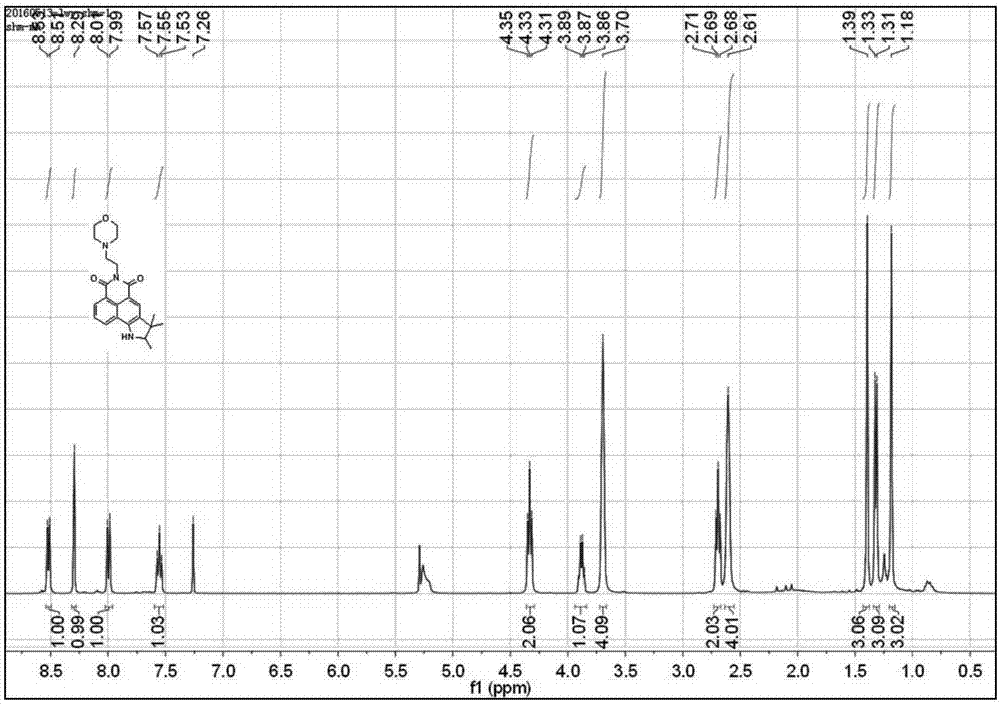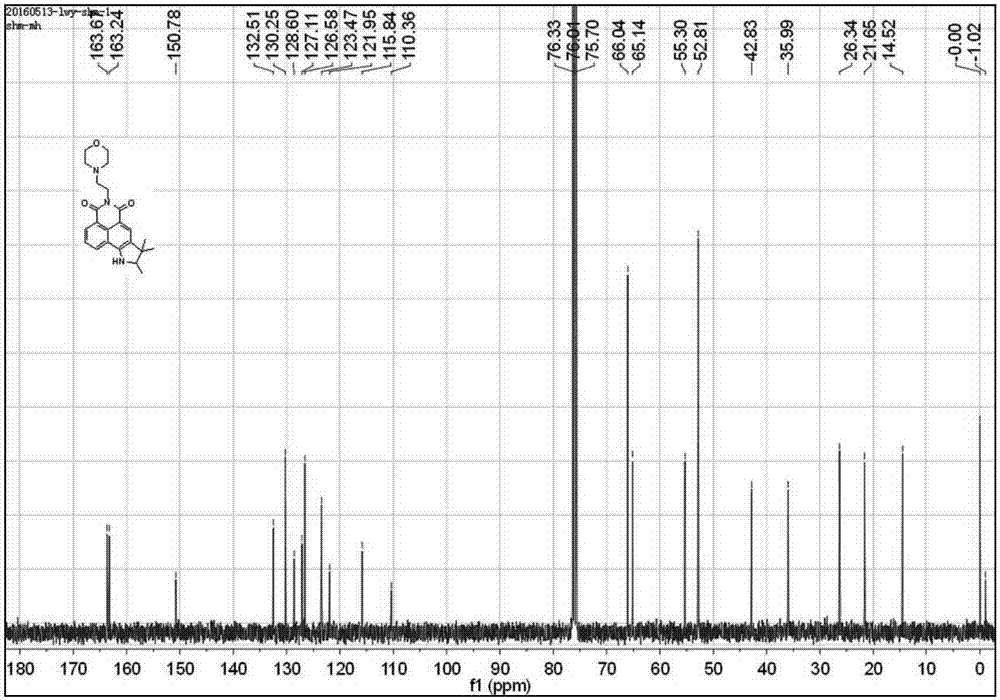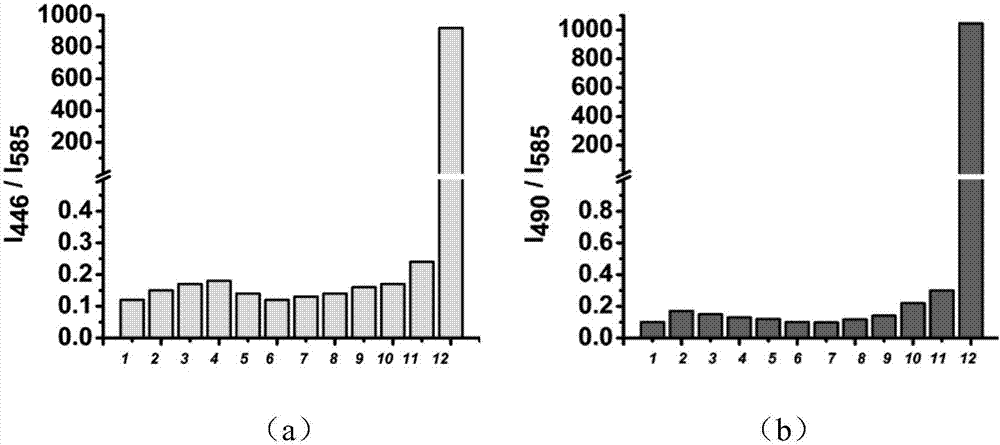Lysosome hypochlorous acid fluorescence probe as well as preparation method and application thereof
A fluorescent probe and hypochlorous acid technology, which is applied in the field of small molecule probes, can solve the problems of few reports of two-photon hypochlorous acid fluorescent probes, and achieve the effects of high sensitivity, wide concentration range and strong specificity
- Summary
- Abstract
- Description
- Claims
- Application Information
AI Technical Summary
Problems solved by technology
Method used
Image
Examples
Embodiment 1
[0042] Example 1 Synthesis of fluorescent probe TPS-Lyso-HClO
[0043] (1) Synthesis of compound 4-bromo-N-(2-morpholinoethyl)naphthalimide:
[0044]In a 100 mL round bottom flask, add 1 mmol of 4-bromo-1,8-naphthalic anhydride, 1.2 mmol of aminoethylmorpholine, and 5 mL of ethanol, heat to reflux for 3 h, cool to room temperature, and depressurize After filtering, the filter cake was washed with ethanol for 2-3 times, and dried under vacuum to obtain 4-bromo-N-(2-morpholinoethyl)naphthalimide as a light gray solid. Yield: 81%.
[0045] 1 H NMR (400 MHz, DMSO- d 6 ) δ 8.57 (dd, J 1 = 7.2 Hz, J 2 = 0.8 Hz, 1H), 8.55 (dd, J 1 = 8.4 Hz, J 2 = 0.8 Hz, 1H), 8.34 (d, J = 7.6 Hz, 1H), 8.22 (d, J =7.6 Hz, 1H), 8.00 (dd, J 1 = 8.4 Hz, J 2 = 7.2 Hz, 1H), 4.18 (t, J = 6.8 Hz, 2H), 3.53 (t, J = 4.8 Hz, 4H), 2.57 (t, J = 7.2 Hz, 2H), 2.47 (s, 4H); 13C NMR (100 MHz, DMSO- d 6 ): 163.30, 163.25, 133.09, 132.07, 131.82, 131.44, 130.20, 129.63, 129.27, 128.68, 123.11, 122.33, 66.6...
Embodiment 2
[0058] Example 2 The selectivity of TPS-Lyso-HClO to different molecules and ions
[0059] The TPS-Lyso-HClO hypochlorous acid fluorescent probe prepared in Example 1 was dissolved in ethanol to prepare a 1 mM stock solution.
[0060] Prepare 5 mL of various conventional ions and active oxygen in phosphate buffer (10 mmol / LPBS, pH=5.5 and pH=7.4) with a concentration of 40 mM, respectively.
[0061] Add 25 μL probe mother solution, 75 μL ethanol and 100 mmol / L analyte solution to the test tube, and dilute to 10 mL with 10 mmol / L PBS with pH=5.5 and pH=7.4 respectively, shake well and perform fluorescence detection (λ ex =390 nm; pH 7.4, λ em =446 nm and λ em =585 nm; pH 5.5, λ em =490 nm and λ em =585 nm), the ratio of the short-wave fluorescence intensity to the long-wave fluorescence intensity is the ordinate (I 446 / I 585 or I 490 / I 585 ), to establish the fluorescence intensity ratio map of different molecules and ions, such as image 3 As shown, 1-12 are probes...
Embodiment 3
[0062] Example 3 TPS-Lyso-HClO Fluorescence Intensity Variations with Different Concentrations of Hypochlorous Acid
[0063] Prepare 10 mL of sodium hypochlorite mother liquor with a concentration of 100 mmol / L for later use (sodium hypochlorite dissociates into ClO in aqueous solution - ).
[0064] Dilute the probe stock solution prepared in Example 1 to a fluorescent probe working solution with a concentration of 2.5 μmol / L, react with 15 hypochlorous acid (0-250 μmol / L) at equal concentrations, and perform fluorescence detection (λ ex =390 nm; pH 7.4, λ em =446 nm and λ em=585 nm; pH 5.5, λ em =490 nm and λ em =585 nm), calculate the fluorescence intensity in each system, take the fluorescence intensity as the ordinate and the scanning wavelength as the abscissa as Figure 4 In a, b, and d, the normalized fluorescence intensity is taken as the ordinate, and the scanning wavelength is taken as the abscissa. Figure 4 In c, where a and b are when the pH is 7.4, and c a...
PUM
 Login to View More
Login to View More Abstract
Description
Claims
Application Information
 Login to View More
Login to View More - R&D
- Intellectual Property
- Life Sciences
- Materials
- Tech Scout
- Unparalleled Data Quality
- Higher Quality Content
- 60% Fewer Hallucinations
Browse by: Latest US Patents, China's latest patents, Technical Efficacy Thesaurus, Application Domain, Technology Topic, Popular Technical Reports.
© 2025 PatSnap. All rights reserved.Legal|Privacy policy|Modern Slavery Act Transparency Statement|Sitemap|About US| Contact US: help@patsnap.com



